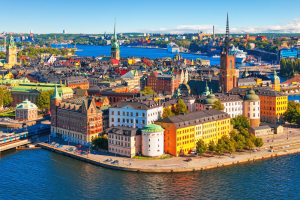An Introduction to Stockholm
Stockholm is the capital of Sweden and with a population of about two million people it is also the country’s largest city. In fact, it is the largest city in Scandinavia.
Stockholm is spread out over fourteen islands in Lake Mälaren, on the east coast of Sweden. The islands of Stockholm are connected by approximately fifty bridges. The city overlooks the Baltic Sea to the east; to the west lie the inland forests and hills Sweden is so famous for.
Further out to sea lies the Stockholm archipelago, which consists of a stunning 24,000 islands. As an old city, Stockholm, Sweden, has an impressive number of historic buildings, countless – almost literally – museums and several palaces. Its most fascinating district is Gamla Stan, the Old Town. Nowadays it is one of the most multicultural cities in all of Europe and a vibrant mix of modern and traditional. More than a third of the city’s surface area is made up of water, while another third consists of green areas. Its proximity to nature results in amazing air quality for a capital city – it ranks third in Europe, after Berlin and Copenhagen.
A Fascinating History
Sigtuna, Sweden’s first capital city, was destroyed by pirates in 1187 and a series of new strongholds was built along the shore of Lake Mälaren. One of the fortresses was built in the area that is now the Old Town; the first records of that were written down in 1252. Uppsala was actually the second capital of Sweden, but was replaced by Stockholm in the 15th century. Stockholm became the center of the Swedish Empire in the 1800s. That empire used to be twice as big as the country is now, consisting of almost the entire Baltic Sea region. Stockholm is still the commercial, demographic, political and cultural center of Sweden, although Gothenburg now has the largest port.
What To Do in Stockholm
Stockholm, Sweden, may seem overwhelming at first. It is a large city and there is so much to see and do. For example, there are more than seventy museums in the city, most of them located in Djurgården. As the seat of the Swedish royal family, there are quite a few royal buildings as well.
But the one place to start a visit to Stockholm is Gamla Stan (Old Town). This is the city’s historic heart and is extremely well-preserved. It consists of narrow cobblestone streets, beautiful mustard-colored buildings, churches, houses, cozy squares and cafés, restaurants and shops. Although the area dates from the 1200s, most of its buildings were built in the 18th and 19th centuries. Landmarks in Gamla Stan are the Royal Palace, the Royal Chapel, Riddarholmskyrkan, Storkyrkan (with its renowned statue of St George and the Dragon) and the Nobel Museum, Medieval Museum, Post Museum and Royal Post Cabinet. Visitors can see the changing of the guard at the Royal Palace in summer.
Most of Stockholm’s museums are concentrated in Djurgården (literally Animal Garden). One of the best museums there is Skansen. This was the first open-air museum in the world and has a vast collection of old rural and town buildings, and a nice Nordic zoo. Other interesting museums are the Vasamuseet and Nordiska Museet. Keep in mind that if you have done all of those, there are still sixty-odd museums left to visit. It can be overwhelming indeed.
In a green city like Stockholm, outdoor activities are hugely popular. The parks and waterways offer excellent opportunities for hiking, cycling, kayaking and walking. Renting a kayak is a suggested alternative way to explore the city.
Visitors are strongly recommended to buy a Stockholm Card. This pass includes transportation on buses, trains and the metro and admission to lots of museums and attractions.
Getting There – Stockholm Travel
Stockholm-Arlanda Airport is Stockholm’s international airport and the city center can be reached by bus, train, taxi or rental car. There are also three minor airports located near the city, used by smaller and budget airlines. The main train station, Stockholm Central, is the focal point for (inter)national trains, long-distance buses and the subway. The main bus station, City Terminal, has connections to most cities in Sweden and other major European cities.
Another way of getting to Stockholm is by boat, possible from Finland, Latvia and Estonia.
Getting around in Stockholm, Sweden, can be done by public transport; the metro, buses, trains, trams, boats and ferries are part of an excellent network. Bicycles are also available for rent and a good option during summer.
Walking around Stockholm’s city center is possible as well.











